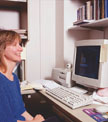
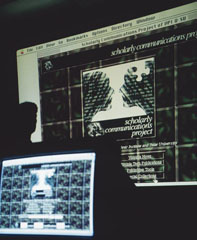 Valerie Hardcastle isn't bothered that people can see her without her knowledge. She just assumes someone may be watching over the live video-feed camera in her office.
Valerie Hardcastle isn't bothered that people can see her without her knowledge. She just assumes someone may be watching over the live video-feed camera in her office.by Sandy Broughton and Sally Harris
In the fast-moving world of information technology, Virginia Tech has been a leader in offering its students, through new teaching and learning technology, opportunities and connections never before possible. The revolution hasn't been without reflection.
Instructional Technology (IT): The theory and practice of design, development, utilization, management and evaluation of processes and resources for learning. The goal of IT is to improve the effectiveness of human learning environments. -- Barbara Seels, Instructional Technology

 Valerie Hardcastle isn't bothered that people can see her without her knowledge. She just assumes someone may be watching over the live video-feed camera in her office.
Valerie Hardcastle isn't bothered that people can see her without her knowledge. She just assumes someone may be watching over the live video-feed camera in her office.
Hardcastle installed the camera for the 250 students in her "cyberized" philosophy course. If they have a question while working online, they can go onto her Web page and get a real-time video feed to determine if she is in the office before they disconnect their computers from the net to call her. While on the Web page, they can type in a short question, and her computer will speak the message to her.
"Students are already fairly alienated in a class that large," Hardcastle says, "so I wanted a way for students to see me as a real person so they won't be intimidated."
Hardcastle, associate professor of philosophy in the College of Arts and Sciences, began her computer-enhanced teaching process to help solve two major problems with traditional lecture courses: many students are too intimidated to speak up, and the traditional courses don't readily accommodate the range of student readiness and learning styles. Her course would center her course on small, ongoing electronic discussion communities through which students converse with peers, teaching assistant, andprofessors. Mixing computer-based and human instruction, she personalizes the course for large numbers of students -- and also increases the quantity and quality of class interactions.
Hardcastle is one of a growing number of faculty members at Virginia Tech, many of whom participate in Tech's Cyberschool Project, who believe that technology can improve the way they teach and the way students learn. The university already offers more than 100 classes on-line, and the list is growing. Many other classes have an on-line component.
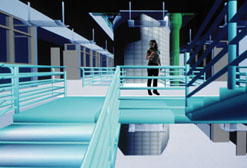 |
The CAVE's 3-D simulation gives the viewer the sense of being able to walk through a building that does not yet exist, although this explorer would not experience simultaneously all the elements shown in this created image of Tech's planned Advanced Communications and Information Technology Center. |
One question often asked about computer-enhanced education is whether it decreases the interaction between students and faculty. "My goal in using the web is not to eliminate personal interactions," Hardcastle says, "but to transform and improve them. As Harlan Miller {of philosophy} put it, 'I aim to foster sophisticated written conversations to which the tongue-tied, the shy, the unfashionably dressed, and the easily intimidated will contribute equally.'"
Through anecdotal and systematic assessment of the course and comparison with traditionally taught courses, Hardcastle found positive preliminary results. Hardcastle found, in a controlled study using student essays, that her students performed better than students in the traditional class on 15 out of 16 criteria for good philosophical writing
Some students don't like the participatory nature of the course at first, but most prefer it by the semester's end, Hardcastle says.
Timothy Mack, head of entomology in the College of Agriculture and Life Sciences, says such courses require an independence and self motivation he's not sure all students possess. Some students alos are intimidated by all the on-line materials, he says.
Cosby Steele Rogers(home economics '67,M.S.), a faculty member in family and child development, says, "We are structuring the Human Development cybercore course as a slow weaning process by which the students gradually take over their own time management. We are building in plenty of feedback."
"Freshmen, especially at large universities, need to form cohort groups, to feel connected," Katherine Cennamo(elementary education '76), a faculty member in instructional design, says. "As we design multimedia courses, we intentionally build in activities, such as discussion groups, in which they can connect and work together."
Tim Luke, a Virginia Tech Cyberschool coordinator and leader in the digitalized enhancement of courses, says the on-line political-science courses he teaches allow students do more work, write more, and be more communicative. "They say in their course evaluations that they learn more, enjoy it more, and get more out of it," Luke says, "and I think that's a function of the fact that they put more into it." However, Hardcastle says, her surveys show students do not even recognize that they are doing more work.
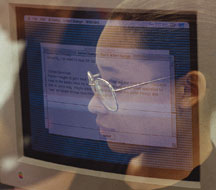
The audio component of Mack's online course has prompted students to say they feel as if the instructor is talking directly to them. His totally on-line core-curriculum class, Insects and Human Society, grew from nine students fall semester to 43 spring semester.
Other universities are following Virginia Tech's lead in some areas of digitally enhanced education. For example, WhizQuiz©, developed by Nick Stone in entomology at Virginia Tech, is now used at Penn State and the University of Nebraska. It is a quiz server on the web that has both actual and practice quizzes, a data bank of questions with color photos, and a quick grading system. "This tells them if they know the material or not," Mack says.
Greg Sherman, an instructional technology faculty member and an instructional designer, is experimenting with embedding optional information on good study skills within the content of the course. "Students who use the instructional options do better. It gives them a chance to identify what they need to learn, how they need to pace themselves, and what resources they want to take advantage of."
"For the computer to bring about a revolution in higher education, its introduction must be accompanied by improvements in our understanding of teaching and learning." -- Nobel Laureate Herbert Simon
Simple comparisons between the old and new ways of learning just don't work, says Len Hatfield, Cyberschool co-coordinator and a leader in the technological advances at Virginia Tech. Students in enhanced courses interact too much among themselves and with the teacher to allow a even comparison.
William Claus of biology, another long-time Cyberschool participant, compared the average scores from five years ago in a traditional lecture class with those of an on-line course in the same subject. The on-line course grades were 10 percent higher, he says. "After that, the courses were too different to compare. The students are learning better, and the students say they are learning better." he says.
Claus now encourages cooperative efforts even in non-enhanced courses, lecturing only 10-15 minutes and then giving students group projects. He is finding that grades in that type course are higher than in traditional courses using the same exams. "Cooperative learning forces them to think and help one another."
"The bottom line is that I would never go back to doing it the old way again because I think students are learning more, becoming more interactive, solving problems," Claus says. He thinks the use of technology may not be the sole reason grades improve, but that emphasis on technology has encouraged the restructuring of courses in ways that have improved learning.
We must look at how computer-mediated communication and network environments are changing the university at large, Tim Luke say. The digital revolution is transforming teaching, administration, faculty life, student life, the research enterprise, and the scholarly documents that come out of research. The ways knowledge is being created, archived, and used are changing profoundly because of computerization.
Luke's statement is corroborated by results of an 18-month project to design, implement, and evaluate four courses utilizing new teaching and learning technologies. The ACCESS project (Asynchronous Communication Courses to Enable Student Success), funded by the Alfred P. Sloan Foundation, found that students reported being more actively involved and investing more time on course work. Faculty members reported a change in their role from a one-way dispenser of information to a facilitator and resource for learning.
ACCESS students reported improved access to class information and materials, to professors, and to other students. They liked the chance to review lecture notes before live lectures, allowing them to concentrate on the lecture without having to take notes. Professors say students were more attentive. E-mail expanded students' opportunities to ask questions and seek information from professors. Chat rooms enabled a team approach to learning and provided information to professors on students' comprehension and concerns. Art Buikema, a biology professor and Cyberschool faculty member, reports tailoring his lectures from student chat-room conversations. "This has changed the way I think about my students and changed the way I teach," he says.
"The Sloan study results presented strong evidence to support what many educators had begun to suspectÐ-that fundamental shifts were occurring in teaching and learning as a result of new technologies," says Tech Provost Peggy Meszaros. "Of course the commitment and the willingness on the part of both the educator and the student needs to be there for this shift to occur."
"Welcome to the year 2000," says Greg Sherman. "It doesn't matter what job you get, you will be faced with technology issues and problems. At Tech, you have a chance to learn and practice. Technology has given us a different way of communicating, and you can't change the way people communicate without changing the way they learn."
"In the last decade, the integration of computing, information, and communications technologies in the work, living, and leisure spaces of everyday life has been dynamic and pervasive. The corresponding integration of technological literacy into the curriculum and community life of the university has become imperative."--Virginia Tech's Academic Agenda 1996-2001.
On Sunday evenings last fall, Ryan Broere left his dorm room, drove to his parents' home in Blacksburg for dinner, and then headed to the Mathematics Emporium for three hours' homework.
Broere, a history major, liked everything about learning in the emporium except getting there. The math emporium offers students a variety of ways to study math. With 500 computers, the emporium is a technologically based experimental answer to the problem of teaching more students with fewer faculty and less money. The on-line mathematics education includes interactive self-paced tutorials, electronic hyper-linked textbooks, on-line quizzes that can be taken three times, lectures on CD-Rom, teaching assistants and math professors standing by to help -- and even live lectures for those who prefer the "old" way.
The "new" way suited Broere, who took Math 1015 in the emporium and then Math 1016 in a traditional classroom. "I liked the fact that it forced me to study," he said of the emporium. It does, said Professor Chris Beattie, "put math in their face."
Not all students like that. Some want the traditional teacher in front of the class even if the class is large. "I sit on the front, and it feels like the teacher is talking to me," one said.
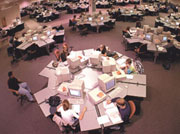 Broere, though, said he liked the requirement of working three hours per week in the emporium and probably wouldn't have spent that much time on math otherwise. He liked working at his own pace instead of sitting in a classroom while professors answered others' questions. He liked being able to go to the emporium at his preferred work time and having quizzes to help him prepare for tests. His grades in Math 1015 and 1016 have been about the same, but the traditional class was "more constraining," he said.
Broere, though, said he liked the requirement of working three hours per week in the emporium and probably wouldn't have spent that much time on math otherwise. He liked working at his own pace instead of sitting in a classroom while professors answered others' questions. He liked being able to go to the emporium at his preferred work time and having quizzes to help him prepare for tests. His grades in Math 1015 and 1016 have been about the same, but the traditional class was "more constraining," he said.
Studies have shown that students learn better under the computer-assisted method, according to Robert Olin, head of the mathematics department. They also learn how to learn. They are understanding core concepts better. Grades are rising and failure rates dropping. Students in subsequent calculus courses are more successful than those coming from traditional classes.
"The design of the emporium courses focuses on student success," Olin said. "We are constantly evaluating the results of the new approach in an attempt to find the best methods for teaching in a new age."
The $1.6 million CAVE (Cave Automated Virtual Environment) project is enhancing learning throughout the university. The CAVE allows students and researchers to immerse themselves in the virtual reality of three-dimensional space and synchronized sound, and they can manipulate images with a wand attached to a high-powered computer. The CAVE lets viewers from all disciplines experience all of the visual and auditory sensations that simulate "being there." Mathematics professors can bring their students inside geometric shapes. Engineering classes can put together and take apart complex structures. Veterinary surgeons can prepare for operations by viewing large-scale simulations of animal organs.
Richard Cole has a vision concerning the CAVE. He will take his students there to a performance of one of the Brandenburg Concertos, with Bach himself playing keyboard. This is not the same as an Elvis sighting. It's a real possibility. Cole is projecting from a long line of digital musical innovations in the music department.
For example, senior music major Jason Russler composes at the piano, then uses notational software to play back the composition and determine how well the harmonies work. He can run it through a synthesizer and hear all the instruments playing his piece. He can write the parts of the composition and have the computer separate them and print out individual scores for different instruments.
Russler can send the composition file via e-mail to his professor for feedback. Russler can go into the recording studio, record from analog to digital, and master a CD of his composition.
Technology has revolutionized music education, from the beginning courses in music history to advanced composition. John Husser, department head, says the students are getting a much better grounding in music. "You see groups of students working on a project in the lab and getting into heated discussions of the meaning of a chord," he said. "And they get into the substance of the music from a technical standpoint, how the music works. They're much more engaged."
With the technological capabilities of the CAVE added into the musical equation, then, it's no great stretch to imagine Bach once more at the keyboard.
Alumni Distinguished Professor of civil engineering professor Siegfried Holzer says technology has both revolutionized his approach to teaching, yet reinforced his belief that interaction with the instructor and other students is crucial to student learning.
"After teaching 22 years, I attended a workshop where I learned not to use the blackboard to transmit information," Holzer said. With support from National Science Foundation, he developed multimedia software for a course on statics that has been requested for use by 51 faculty members from 31 universities and is also available through the Web. He believes teachers are even more important when students use multimedia tools, because more of the professors' time is freed to challenge students.
Another engineering professor, Robert Broadwater, of electrical engineering, however noted that developing cybercore courses is very time consuming. He estimated that developing his course on object-oriented programming and C++ would take 700 hours, but his work on it ended up exceeding 1,000 hours.
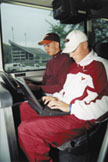 For athletes on the road, learning is greatly enhanced through an academic support initiative called ATECH. For track team member Brandi Smith and others, ATECH means being able to keep up while on the road instead of spending exhausting Sunday evenings trying to catch up on studies and papers after a weekend of traveling. Smith leaves campus for competition each Thursday or Friday during track season. Before ATECH, she would try to write papers by hand on the road, then type them Sunday nights when she was also trying to catch up on the classes she missed and the assignments due the next day. "I'd be up all night," she said.
For athletes on the road, learning is greatly enhanced through an academic support initiative called ATECH. For track team member Brandi Smith and others, ATECH means being able to keep up while on the road instead of spending exhausting Sunday evenings trying to catch up on studies and papers after a weekend of traveling. Smith leaves campus for competition each Thursday or Friday during track season. Before ATECH, she would try to write papers by hand on the road, then type them Sunday nights when she was also trying to catch up on the classes she missed and the assignments due the next day. "I'd be up all night," she said.
Now, with an ATECH laptop, Smith can do her papers on the bus or in the hotel room. Smith can also put on her resume that she has learned a great deal about computers and computer programs through ATECH
Connecting real-world examples to classroom content is a teaching technique at which cybercourses excel. Students in John Seiler's dendrology (woody-plant-identification) course would find it impossible to walk through all the forests on the East coast identifying trees. Textbooks might show only one leaf, often in black and white, one twig, one part of the tree's bark. But a cybercore program called Woody Plant ID, developed by a team with Seiler's leadership, allows the students to see several colorful leaves from a tree, different samples of its bark, a few twigs, the entire tree -- and even lets them pull up two similar trees side by side on the screen for comparison.
Virginia Tech's support of a group of "cybercore" faculty to effect transformation in courses crosses all disciplines, sometimes even teaming faculty from several colleges to create courses, ensure a standard of learning, and provide students the best opportunities for learning. Supported with funding from the university's Center for Innovation in Learning and individual colleges, the cybercore courses put a new twist on old subjects:
History of Architecture students who have no other way of knowing how a cathedral took shape over many years can take advantage of a CD-ROM titled "Monasteries of Western Europe" that allows them to manipulate images to reconstruct a building visually.
The 600 or so students in introductory sociology can take five practice quizzes that would have required 15,000 sheets of paper and hundreds of hours to grade in a traditional class.
Students who could not otherwise attend classes -- a man hospitalized with a broken back, people with learning disabilities, people with jobs during class hours, people who travel, and on-campus students for whom a biology or dendrology class time conflicts with a course in their major -- now can access the cybercourses.
New technology is not a panacea for everything that ails education, some professors point out, but is another tool for its enhancement. For one thing, said Tim Mack, whose students can dissect a virtual cockroach, a computer cannot (yet) provide virtual odors, and a sense of smell is important in teaching entomology. "Cybercore is great," Mack said, "but we can't replace the entire university with a Web page. There will be times we'll have to have people in a lab."
However, as Cosby Rogers says, new technologies provide a way that "we can explore which elements or activities are best suited to technology and which to other kinds of delivery--lecture, small group, or individual meetings. We want to match the teaching techniques to both the content of the course and the desired outcome."
"The number of workers who use or rely on computers and computerized technology has increased dramatically, and new ways to use this technology are being found every day." -- Virginia's Changing Workplace
"We need to think about how best to prepare students for a very different future," says William E. Dugger(industrial arts education '58), Jr., a former Tech faculty member directing the NASA- and NSF-sponsored "Technology for All Americans" project to create national standards for the field of technology education. "The prevalence of technology in our daily lives has vastly changed the notion of what it means to be an educated person."
A major study by Virginia Tech and the Information Technology Association of America revealed that extensive information-technology worker shortages exist throughout the United States despite aggressive retraining and hiring programs. The study found that the two most challenging training issues for businesses today are the fast pace of changing technology and the difficulty of finding qualified trainers.
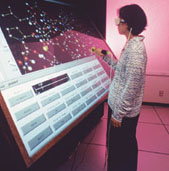 |
"The digital revolution is here," said Virginia Tech President Paul Torgersen. "The future economic competitiveness of the nation is dependent on maintaining a qualified flow of information-technology workers. We must look to creative partnerships among industry, associations, education, and government to help close the worker shortage gap. No single sector alone can solve the problem." |
|
|
Students in enhanced courses get skills for such positions from working in a computer environment, Len Hatfield said. They learn navigation, control, and application skills, as well as critical-thinking and problem-solving skills relevant to the digital domain and elsewhere.
Investment in technology makes sense, both economically and pedagogically, Tim Mack said. "Virginia Tech is an information-technology-oriented university. By doing well in this venue, we can increase the stature of Virginia Tech. Being a land-grant university is a big advantage. We have agents statewide in every county. If we develop ways of supporting instruction with the cooperative-extension service, the agents could potentially give us local access to testing sites. The county-agent system makes us a giant, the distance-learning university, if we use it right."
Investment in technology makes sense, both economically and pedagogically, Tim Mack said. "Virginia Tech is an information-technology-oriented university. By doing well in this venue, we can increase the stature of Virginia Tech. Being a land-grant university is a big advantage. We have agents statewide in every county. If we develop ways of supporting instruction with the cooperative-extension service, the agents could potentially give us local access to testing sites. The county-agent system makes us a giant, the distance-learning university, if we use it right."
"How do you get faculty to sit--happily--through workshops on using technology in the classroom? Give them a new computer for their trouble." -- Chronicle of Higher Education article on Tech's Faculty Development Institute.
The rapid infusion of technology into education and everyday life at Virginia Tech has led to an interesting role reversal: along with their students, faculty are now the learners in this new field. Through a wide variety of formal and informal exchanges, faculty are educating themselves about technology and broadening educational options for their students.
The Faculty Development Institute (FDI), initiated in 1993, has conducted workshops on using technology in the classroom for more than 1,400 professors from 90 departments. The faculty get state-of-the-art computers, along with software and network connections, and are invited to update both their knowledge and their computers every four years. The FDI has generated several discussion groups that regularly exchange information on using new technologies in the classroom and on the network.
"There is a level of interest and a degree of access to equipment among the Tech faculty that make it possible to do a lot of things other universities cannot match," Luke says.
Yahoo! Internet Life (http://www.zdnet.com/yil/) magazine recently recognized Virginia Tech as the 15th most wired university in the nation.
Computer-enhanced education raises important questions about the nature of the university -- questions about the research process, promotion-and-tenure requirements, questions of whether computer-assisted courses represent teaching or research or outreach or something different, questions of storing and sharing on-line documents, questions of the quality of courses on-line.
"Virginia Tech is trying to put the same quality classes on the network that it presents on campus face to face," Luke said. "How do you maintain quality? How much can be outsourced for someone's degree? It raises questions about what we know as a university."
Perhaps the largst problem, Luke says, is that computer equipment is "very expensive, very error prone, and very short-lived in terms of its utility." Education has been accustomed to "using things that last decades, not months."
Students, he says, are usually less worried technology than the professors. After all, he pointed out about first-year students, "PCs arrived in schools about the same time they did." More than 70 percent of all incoming students are arriving at Tech with a computer. That's the reason he, Hatfield, and the Cyberschool faculty proposed the computer requirement for incoming freshmen -- to give all students the same opportunities.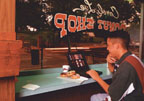
Beginning with the freshman class of 1998, each incoming student will be required to have a personal computer. Virginia Tech is the first college or university in Virginia, and one of the first public schools in the country, to implement such a requirement. Several departments and colleges already had a computer requirement. Every residence hall at Virginia Tech is wired with EtherNet connections, as are laboratories, lecture rooms, and offices.
No one will be denied admission because of an inability to afford a computer. The university has developed several assistance programs, and affordable leasing options are available.
"There's no way the university can build enough labs to serve everybody," Luke said. "The requirement provides not merely a machine to compute with, but also access to help services, digital libraries, the Tech library, the Internet, and all the things you can do with it: personal communications, access to instructional spaces to do things that can't be done in a face-to-face class, on-line communities all over the world.
"It will level the set of expectations for faculty and formalize what's the case already," Hatfield said
Sandy Broughton and Sally Harris are the public-relations coordinators for the College of Human Resources and Education and the College of Arts and Sciences, respectively, at Virginia Tech. Liz Crumbley, Catherine Doss, and Matt Winston of the University Relations staff also contributed information for this story.
Home | News | Features | Research | Philanthropy | President's Message | Athletics | Alumni | Classnotes | Editor's Page